MOTORWAY AND TRAFFIC ASSISTANT
The Motorway and Traffic Assistant is a driving aid system designed for use on long motorway journeys, where traffic is flowing or in jams.
Depending on the vehicle, this system comprises the adaptive cruise control function Stop and Go ADAPTIVE CRUISE CONTROL and the “Lane Centring” function.
When these two functions are activated simultaneously, the system allows the driver to:
- maintain vehicle speed based on a previously saved speed;
- adjust the distance between this vehicle and the vehicle in front;
- direct the vehicle to the centre of the lane.
The Stop and Go adaptive cruise control function
Based on information from a radar or camera, the Stop and Go adaptive cruise control function gives you the option of maintaining a selected speed, known as the cruising speed, while keeping a safe distance from the vehicle in front in the same lane.
If the vehicle in front stops, the Stop and Go adaptive cruise control may brake your vehicle to a complete stop before setting off again.
The system controls acceleration and deceleration of your vehicle using the engine and braking system.
The Stop and Go adaptive cruise control function can be activated from 0 to 105 mph (0 to 170 km/h) according to conditions on the road (traffic, weather etc.).
It is represented by the following symbol ADAPTIVE CRUISE CONTROL.
Note:
- the driver must observe the maximum speed limit and safe distances in the country where they are driving;
- the Stop and Go adaptive cruise control can brake the vehicle up to a third of the braking capacity. Depending on the situation, the driver may need to brake harder.
The Stop and Go adaptive cruise control does not trigger an emergency stop and its braking capability is limited.
Important: you should keep your feet near the pedals and your hands on the steering wheel at all times to prepare for any event.
The “Lane centring” function
Using information from a camera, the “Lane Centring” function manipulates the steering system to direct the vehicle to the middle of the lane. This function is only available while the Stop and Go adaptive cruise control is activated ADAPTIVE CRUISE CONTROL.
If the conditions allow it, the function is available between:
- 0 mph and 99 mph (160 km/h) approximately with a vehicle in front;
or
- 37 mph (60 km/h) et 99 mph (160 km/h) approximately without a vehicle in front.
The “Lane Centring” function is a comfort feature. It is represented by the symbol .
Note: in the event of a sharp bend, the function’s lateral retention capacities are limited and require the driver to take immediate action on the steering wheel.
Additional information
Depending on the vehicle, the “Motorway and Traffic Assistant” function may be used with other driving aid functions.
Please note that:
- activating the speed limiter causes deactivation of the system;
- the system cannot be activated when the “Park Assist” function is active;
- activation of the “Lane Centring” function leads to suspension of the “Lane Departure Warning” or “Lane Keep Assist” functions if these have been activated. They will be reactivated when the driver decides to stop the “Lane Centring” function.
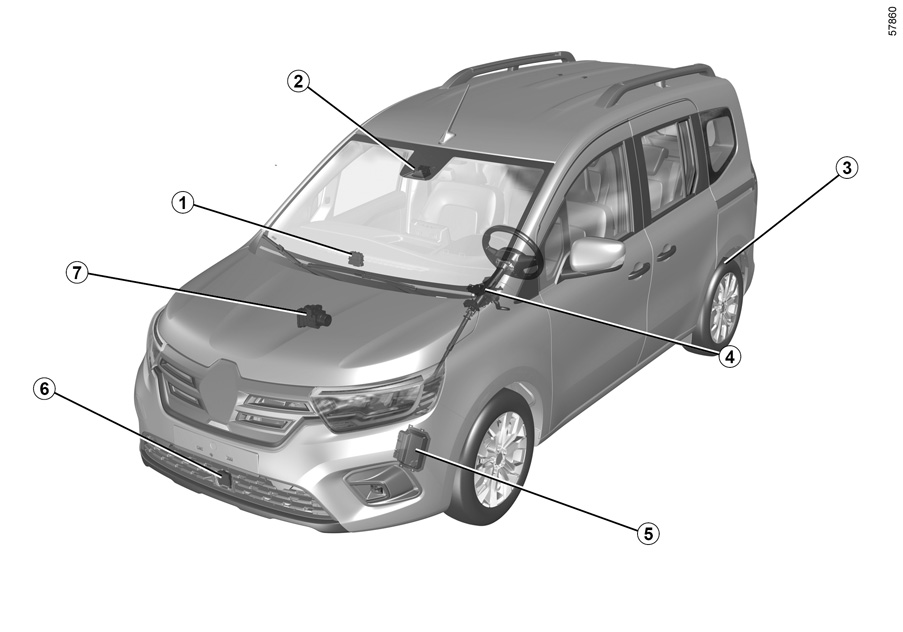
Computer 1
Receives information from the radar and camera to determine the vehicle trajectory and speed (acceleration or braking). Amongst other things, it controls the system activation/deactivation parameters (door opening, etc.).
Camera 2
Detects markings on the ground and the position of vehicles on the various traffic lanes. It complements the information transmitted by the 6 radar.
Make sure the windscreen is not obscured (by dirt, mud, snow, etc.).
Electronic parking brake 3
It the vehicle stationary under certain conditions.
Power-assisted steering 4
Operates the front wheels to assist the trajectory of your vehicle according to details transmitted by the 1 computer. It also enables detection of the driver's hands on the steering wheel.
Engine computer 5
It controls and directs the engine to carry out the required acceleration.
Radar 6
Calculates the distance between your vehicle and the vehicle in front.
The system's maximum range is approximately 150 m. This may vary according to the road conditions (ground relief, weather conditions, etc.)
Ensure that the radar area is not obstructed (dirt, mud, snow, a badly fitted front number plate), impacted, modified (including painting) or hidden by any accessory fitted on the front of the vehicle (on the grille or logo etc.).
Active vehicle control 7
This system provides information on vehicle dynamics to the computer 1 (speed, lateral acceleration, etc.) and acts on the braking system to control deceleration and to keep the vehicle stationary.
The radar and camera zones must be kept clean and free of any tampering in order to ensure the proper operation of the system.
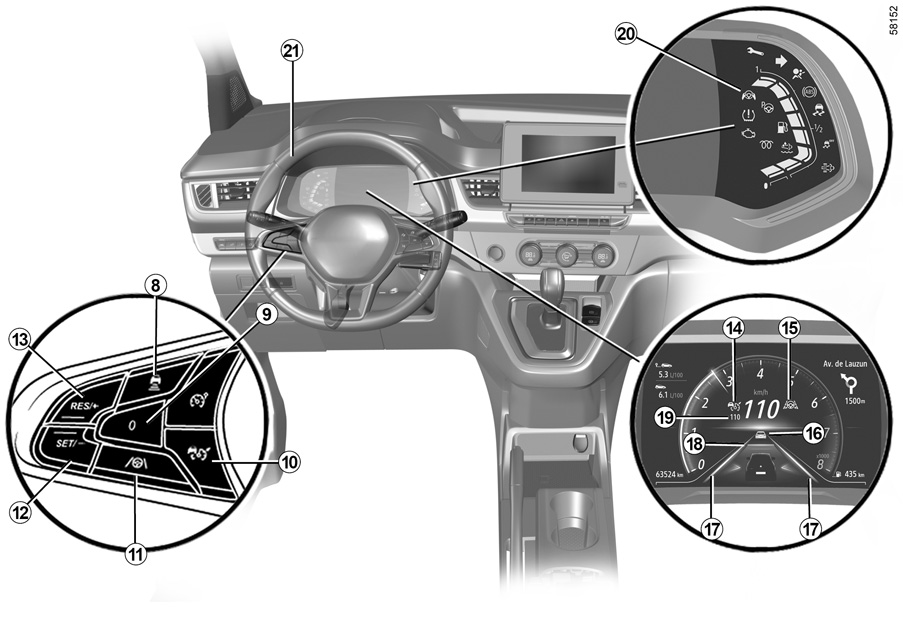
Controls
8 Safe distance settings
9 Set active functions to standby (with cruising speed saved) (0).
10 Stop and Go Adaptive cruise control main stop/start switch .
11 “Lane Centring” function activation/deactivation switch .
12 Cruising speed activation, storage and decrease switch (SET/-).
13 Switch to activate and increase cruising speed or to recall the memorised cruising speed (RES/+).
Displays on the instrument panel
14 Stop and Go adaptive cruise control function warning light .
15 “Lane Centring” function warning light .
16 Vehicle in front.
17 Left-hand and right-hand line indicators.
18 Stored safe distance.
19 Stored cruising speed.
20 “Hands off steering wheel” detection warning light .
Steering wheel 21
The driver must always keep their hands on the steering wheel. If too much force is applied when turning the steering wheel, the “Lane Centring” function is put on standby so the driver can regain control of the vehicle.
Under certain conditions (sharp bends, etc.) a vibration may be triggered on the steering wheel to warn the driver that they must regain control of the vehicle.
If the driver does not handle the steering wheel (no hands are detected) the “Lane Centring” function is deactivated after several alerts.
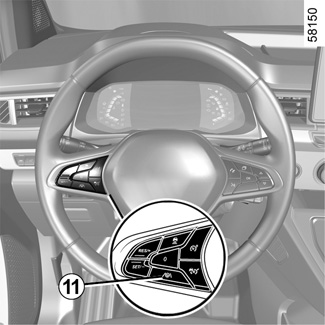

Activating the “Lane Centring” function
Once the Stop and Go adaptive cruise control is activated ADAPTIVE CRUISE CONTROL, press button 11 to activate the “Lane Centring” function. The message “Lane centering activated” appears on the instrument panel accompanied by the 15 warning light and the symbol to confirm that the function is activated.
Note: you must keep your hands on the driving wheel when using the “Lane Centring” function. The symbol is displayed to confirm that the function is activated.
The warning light 15 is displayed in green and the left-hand and right-hand line indicators 17 are displayed on the instrument panel to confirm that the function is activated and directing your vehicle to the centre of the lane.
Note: if you press button 11 when the Stop and Go adaptive cruise control is not activated, the message: “First activate Adapt. cruise ct” appears on the instrument panel.
“Lane Centring” function on standby
The “Lane Centring” function is put on standby automatically when:
- the Stop and Go adaptive cruise control is put on standby ADAPTIVE CRUISE CONTROL;
- the system no longer detects the lines or only one line is detected in your lane;
- the lane is too narrow or too wide;
- the system does not detect any hands on the steering wheel;
- the bend is too sharp.
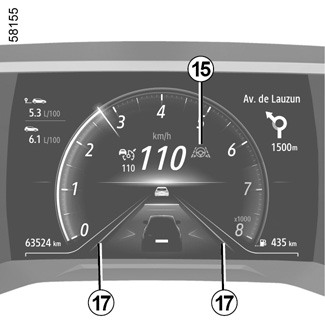
- the vehicle speed is over approximately 99 mph (160 km/h);
- the vehicle speed is below approximately 37 mph (60 km/h), without any vehicle in front;
- the vehicle touches or breaches a line;
- the system is temporarily disrupted (for example: camera obscured by dirt, mud, snow,condensation, etc.).
Certain actions carried out by the driver also suspend the “Lane Centring” function:
- activating the indicators;
- too much force is used when handling the steering wheel.
Standby of the function is confirmed by the 15 warning light and the left-hand and right-hand line indicators 17 appearing in grey on the instrument panel.
Once the conditions are met, the function again directs the vehicle to the centre of the lane. The 15 warning light and left-hand and right-hand line indicators 17 are displayed in green on the instrument panel.
You can affect the vehicle trajectory at any point by turning the steering wheel.
Important: you should keep your feet near the pedals and your hands on the steering wheel at all times to prepare for any event.
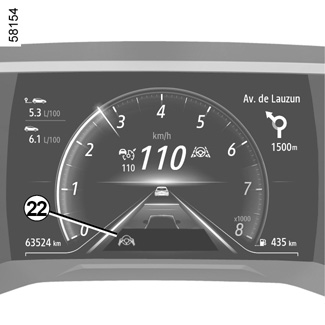
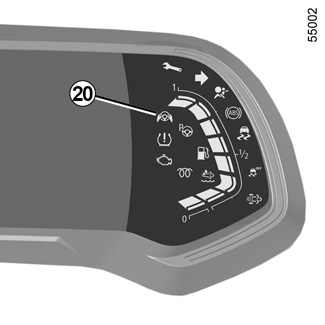
“Hands off steering wheel” detection warning
When the “Lane Centring” function no longer detects your hands on the steering wheel, several warning levels will be triggered:
- after 15 seconds, the message: “Keep hands on steering wheel” is shown in yellow on the instrument panel 22;
- after approximately 30 seconds, the message: “Keep hands on steering wheel” appears on the instrument panel 22 and the warning light 20 appears in red, accompanied by an audible signal of gradually increasing volume;
- after approximately 45 seconds, the audio sources go on standby, the audible signal sounds continually, the warning light 20 is switched off and the message “Lane centering deactivated” appears in red on the instrument panel 22: the “Lane Centring” function is deactivated.
Note: in some situations, the Lane Centring function may no longer detect your hands on the steering wheel and may sound a signal:
- the vehicle is moving along a long straight lane and the driver’s hands are immobile on the steering wheel;
- the driver is holding the steering wheel very lightly;
-...
If the “Lane Centring” function is deactivated due to the driver’s hands not being detected on the steering wheel, the Stop and Go adaptive cruise control function continues to function.
In the first two alert levels, when the system again detects the presence of the driver’s hands on the steering wheel, the system stops the alerts. The function continues to direct the vehicle to the centre of the lane.

In the case of a sharp bend
In the case of a sharp band, and depending on the vehicle speed, the function’s side retaining capacities will be limited and require the driver to carry out immediate action on the steering wheel so that the function can continue to maintain the vehicle in the centre of the lane.
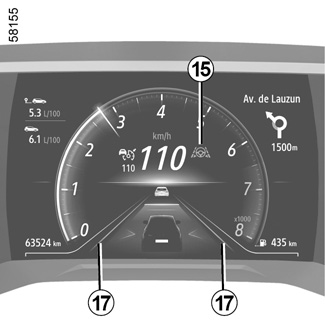
If the driver does not intervene, the function triggers the vibration of the steering wheel to signal that the vehicle is about to breach a line and that the driver needs to carry out immediate action.
The 15 warning light and the left-hand or right-hand line indicator 17 appear in red on the instrument panel.
If the vehicle crosses a line completely and moves out of lane, the “Lane Centring” function is put on standby. Standby of the function is confirmed by the 15 warning light and the left-hand and right-hand line indicators 17 appearing in grey on the instrument panel.
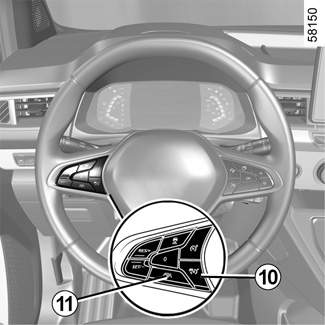
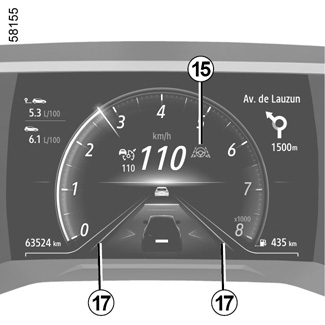
Deactivating the “Lane Centring” function
The “Lane Centring” function is deactivated when:
- you press switch 11. The function’s deactivation is confirmed by the appearance of the message: “Lane centering deactivated” on the instrument panel.
Note: pressing the 11 switch once deactivates the “Lane Centring” function but does not affect operation of the Stop and Go adaptive cruise control function;
- the Stop and Go adaptive cruise control is deactivated ADAPTIVE CRUISE CONTROL.
Note: pressing the 10 button once deactivates both the Stop and Go adaptive cruise control function and the “Lane Centring” function;
- the system will no longer detect the driver’s hands on the steering wheel for a period over 45 seconds approximately.
The 15 warning light and the left-hand and right-hand line indicators 17 disappear from the instrument panel.
Temporary unavailability
The radar is able to detect vehicles in front of your vehicle. The system cannot operate correctly if the radar detection area is obscured or if its signal is disrupted.
If the radar detection area is obstructed or the radar signal is disrupted, the message “Front radar no visibility” is displayed on the instrument panel and the Stop and Go adaptive cruise control is interrupted. The green warning light disappears to confirm that the function has been automatically deactivated.
Ensure that the radar area is not obstructed (dirt, mud, snow, a badly fitted front number plate), impacted, modified (including painting) or hidden by any accessory fitted on the front of the vehicle (on the grille or logo etc.).
Conditions in certain geographical areas may hinder the function, for example:
- arid zones, tunnels, long bridges or lightly used roads without road lines, without signs or trees nearby;
- a military or airport zone.
You must leave such areas in order for the function to work.
In all cases, if the message is not erased after the engine is restarted, please contact an authorised dealer.
Operating faults
If a Lane Centring function operating fault is detected, the message “Lane centering to check” is displayed on the instrument panel and the function is disabled.
The Stop and Go adaptive cruise control function remains in operation.
Consult an approved dealer.
If a Stop and Go adaptive cruise control function operating fault is detected, the message “Check Adaptive Cruise control” appears on the instrument panel and both the Stop and Go adaptive cruise control and Lane Centring functions are suspended.
Consult an approved dealer.
If an operating fault is detected on one or more components of the “Motorway and Traffic Assistant” system, the © warning light appears on the instrument panel, alongside, depending on the nature of the fault, the message:
- “Front camera to check”;
- “Front radar to check”;
- “Camera/Radar to check”;
- “Check vehicle”.
The Stop and Go adaptive cruise control function and Lane Centring function are both suspended.
Consult an approved dealer.
The “Motorway and Traffic Assistant” function is an additional driving aid. This system does not take the place of the driver.
Therefore, it can under no circumstances replace the driver’s responsibility to respect speed limits and safe distances and to be vigilant (the driver must always be ready to brake).
The driver must always be in control of the vehicle. The driver must always adapt their trajectory and speed according to the surroundings and traffic conditions.
The “Motorway and Traffic Assistant” uses the Stop and Go adaptive cruise control function and the Lane Centring function. It must only be used on a motorway or multi-lane road (separated by a barrier).
It must not be used in heavy traffic, on winding or slippery roads (black ice, aquaplaning, gravel) or during bad weather (fog, rain, side winds etc.).
There is a risk of accidents.
The “Motorway and Traffic Assistant” function is an additional driving aid. it can under no circumstances replace the driver's responsibility to respect speed limits and safe distances and to be vigilant.
The driver must always be in control of the vehicle.
The driver must always adapt their trajectory and speed according to the surroundings and driving conditions, regardless of system indications.
Except for lines delimiting lanes, traffic indicators (traffic lights, traffic signs except for speed limit signs within the limits of the system’s detection capacity, pedestrian crossings, etc.) are not recognised by the system. These do not trigger any alert or reaction by the system.
The “Motorway and Traffic Assistant” uses the Stop and Go adaptive cruise control function and the Lane Centring function. The system should under no circumstances be taken to be an obstacle detector or an anti-collision system.
The Motorway and Traffic Assistant function must only be used on a motorway or multi-lane road separated by a barrier.
System servicing/repairs
- In the event of an impact, the radar and/or camera alignment may be changed and its operation may consequently be affected. Deactivate the system and consult an authorised dealer.
- Any work in the proximity of the radar and/or camera (replacements, repairs, windscreen modifications, paintwork etc.) must be carried out by a qualified professional.
Only an authorised dealer is qualified to service the system.
Deactivating the system
You must deactivate the system if:
- the vehicle is travelling on a windy road;
- the vehicle is being towed (breakdowns);
- the vehicle is towing a trailer or a caravan;
- the vehicle is being driven in a tunnel or close to a metallic structure;
- the vehicle arrives at a toll point, a roadwork area or on a narrow lane;
- the vehicle is being driven up or down a very steep slope;
- the visibility is poor (glaring sun, fog etc.);
- the weather conditions are poor (rain, snow, side winds, etc.);
- the vehicle is being driven on a slippery road surface (rain, snow, gravel, etc.);
- the camera area has been damaged (e.g. interior or exterior windscreen area); the windscreen is cracked or distorted;
- the radar area has been damaged (impacts, etc.) ;
- the surface of the steering wheel is damaged or damp.
In the event of the system behaving abnormally, deactivate it and consult an authorised dealer.
Some conditions can disrupt or damage the operation of the system, for example:
- obstruction of the windscreen or the radar area (by dirt, ice, snow, condensation etc.) Frequently check the cleanliness and condition of the windscreen, front wiper blades and front bumper;
- a complex environment (tunnel etc.);
- poor weather conditions (snow, heavy rain, hail, black ice, etc.);
- poor visibility (night, fog etc.);
- poor contrast between the vehicle preceding it and the surrounding area (e.g. white vehicle in a snowy area etc.) ;
- being dazzled (glaring sun, lights of vehicles travelling in the opposite direction etc.);
- narrow, winding or undulating road (tight bends etc.);
- the tar lines detected as a line by the system;
- narrowing/widening lanes;
- road markings which are worn, lacking in contrast or very widely spaced from one another (lines partially erased etc);
- multiple markings on the road (roadworks area, slip roads connecting to adjacent motorways, hard shoulder etc.);
- road signs that do not include an arrow, located in a motorway exit;
- an area with low connectivity that makes it impossible to geolocate the vehicle or maps that are not up-to-date;
- a slower vehicle with a significant difference in speed;
- use of mats not adapted to the vehicle. On the driver’s side, only use mats suitable for the vehicle, attached with the pre-fitted components, and check the fitting regularly. Do not lay one mat on top of another. There is a risk of wedging the pedals.
In these cases, the system may wrongly intervene.
- Risk of unwanted braking or acceleration.
- Risk of unwanted, incorrect correction or no correction of trajectory.
Many unforeseen situations may affect the system operation. Certain objects or vehicles that can appear in the camera or radar detection zone may be interpreted by the system incorrectly, possibly leading to inappropriate acceleration or braking.
You should always be attentive to sudden events that might occur while you are driving. Always maintain your vehicle under control by keeping your feet near the pedals and your hands on the steering wheel, so that you are ready to act in any event.